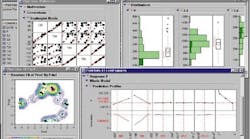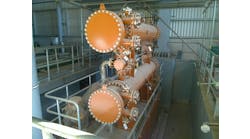Like many chemical processing companies, Dow Chemical Co. embraced the Six Sigma standard for quality improvement. Dow launched its corporate Six Sigma program at the end of 1998. Statistical software supplied by JMP, a business unit of SAS, based in Cary, N.C., played an important role in helping the company achieve its quality goals across customer industries and manufacturing plants throughout the world. In fact, Dow says, the software was a key factor in allowing it to achieve its goal ," $1.5 billion in cumulative earnings in 2002,"one year earlier than originally planned.
In the mid-1990s, Dow realized that it needed to establish one standard statistics software package across the company. Using diverse packages made training a thorny issue, explains Dan Obermiller, Six Sigma master black belt and JMP administrator for Dow. The company had to customize training to fit the various programs in use at different manufacturing facilities. "We found that we were spending [more] time creating training than we were actually doing it," says Obermiller.
The company came up with a list of requirements for its statistical software. "We were looking for software that would meet the needs of 95 percent of the people 95 percent of the time," says Obermiller. "It needed to work under Windows and be affordable." Dow evaluated a number of Windows-based packages considering key criteria such as ease of use, accuracy, documentation, price and the ease with which it can be expanded or customized. JMP emerged as the best option.
First installed under Windows in 1995, JMP software is now used in Dow projects ranging from plant optimization to supply chain management. "The most common area is planning some design experiments in a plant, to find out how best to run that plant," says Jeff Sweeney, senior statistician for Dow. "Sometimes it's as simple as trying to find out where a problem is. For example, maybe we've got shipments that are being damaged. How are they being damaged? Is it our carrier's fault or was it due to a flawed packaging design?"
A number of Dow employees use the software to mine company data, using JMP's 5.0 partition models, PLS and neural networks, Obermiller says. Meanwhile, JMP's Design of Experiments capabilities allowed users to build complex models and pinpoint root causes of any failures or deficiencies. For example, the company used the software to optimize an olefin foam used to protect car passengers from serious head injuries during a crash. A design for five variables was created and studied in JMP. The design identified the significance of each variable, as well as interactions between variables. Then, a model was developed for predicting foam performance properties. As a result of the study, "Optimization of High-Efficiency Energy Absorbing Olefinic Foam Headliner Countermeasures via a Statistical Design of Experiment," automobile manufacturers and Tier 1 suppliers will be able to minimize design cycle times for foams of this type.
JMP has helped Dow realize some less-tangible benefits as well. "[JMP] has given people a standard way of looking at data, which is very helpful," Obermiller says. "It raised the level of statistical awareness throughout the company and provided a common language related to data analysis." With other software programs, a Dow employee making a presentation at the company might use graphs to compare key differences between corporate groups. JMP goes beyond visual differences, highlighting statistical differences, says Obermiller, who adds that the software is extremely user friendly. "It has given people a new way to play with data," he says. "It's very easy to just start clicking on bars in JMP." For more information on JMP, visit www.jmp.com.
U.K.-based Hyperlast manufactures specialty polyurethane elastomers used in a wide variety of manufacturing and engineering applications. Within the past few years, chemical processing innovations at the company have increased the complexity of its production methods, challenging support systems to keep up with evolving technologies. For example, the company uses Wonderware's InBatch to manage its batch recipes, but it found that InBatch's proprietary database could not be integrated with its other business-control systems.
Most modern database programs such as Microsoft Access, Oracle and SyBase allow for integration via the Open DataBase Connectivity (ODBC) standard. ODBC is a database programming data pipeline, or API, that allows a programmer to abstract a program from its database. With the ODBC API, a programmer can write one program that can access any database with an ODBC driver ," all database calls are made to ODBC rather than the database. Unfortunately, InBatch's embedded database, Raima Database Manager (RDM), did not have an ODBC driver. As a result, Hyperlast could not synchronize or report data from InBatch.
The company faced a dilemma: it could either change its entire system architecture, an extensive and costly process involving bugs, retraining and downtime, or it could find a way to access the existing InBatch database and integrate the data via industry standards.
System migration simply was not an option. "Our company installed and used InBatch for many years in different locations and [company users are comfortable with] this product," says Peter Davis, Hyperlast's IT director. "Replacing InBatch would be a huge and expensive task, and our familiarity with Wonderware products and local representatives is very valuable."
A third-party solution was at hand: RDMi from ITTIA could create a data pipeline between RDM databases such as InBatch's and ODBC and allow for database integration and reporting. "We did some serious investigation, but ODBC was the only alternative," says Davis. "There was no [possibility of] access and data synchronization until we learned about RDMi."
ITTIA developed RDMi to offer a reliable embedded data management tool to thousands of databases developed with RDM. RDMi has been used successfully by many organizations in many different fields, from chemical processing and manufacturing to building access management. Companies such as Hyperlast need RDMi to provide ongoing database reporting from solutions such as InBatch, others use it to migrate data to a new system. RDMi allows companies to keep legacy data when moving to a new system; without a data pipeline, data would be lost, or would have to be be re-keyed ," an inaccurate and expensive prospect.
Typical analyses in JMP allow Dow researchers to explore relationships among variables, interactively and in several ways, and provide a means for optimizing processes.
Hyperlast's implementation was not without challenges. Although installing RDMi was straightforward, and the product worked right out of the box, Hyperlast found that its SQL queries took too long to execute ," up to four minutes in one case. This speed was unacceptable. ITTIA product support looked at the SQL queries Hyperlast was using and discovered that each query was searching the entire database ," more than 134,000 records. Hyperlast needed to create a new database key in order to execute the search more efficiently. ITTIA helped Hyperlast structure its queries more efficiently, and performance problems disappeared.
ITTIA is now promoting db.linux, an open-source combination network and relational embedded database engine with no development or runtime fees. The core code is a much-improved version of the RDM engine, and is available for evaluation at the company's Web site, www.ittia.com.
Data Pipeline Helps Hyperlast Access Batch Data
Like many chemical processing companies, Dow Chemical Co. embraced the Six Sigma standard for quality improvement. Dow launched its corporate Six Sigma program at the end of 1998. Statistical software supplied by JMP, a business unit of SAS, based in Cary, N.C., played an important role in helping the company achieve its quality goals across customer industries and manufacturing plants throughout the world. In fact, Dow says, the software was a key factor in allowing it to achieve its goal ," $1.5 billion in cumulative earnings in 2002,"one year earlier than originally planned.
In the mid-1990s, Dow realized that it needed to establish one standard statistics software package across the company. Using diverse packages made training a thorny issue, explains Dan Obermiller, Six Sigma master black belt and JMP administrator for Dow. The company had to customize training to fit the various programs in use at different manufacturing facilities. "We found that we were spending [more] time creating training than we were actually doing it," says Obermiller.
The company came up with a list of requirements for its statistical software. "We were looking for software that would meet the needs of 95 percent of the people 95 percent of the time," says Obermiller. "It needed to work under Windows and be affordable." Dow evaluated a number of Windows-based packages considering key criteria such as ease of use, accuracy, documentation, price and the ease with which it can be expanded or customized. JMP emerged as the best option.
First installed under Windows in 1995, JMP software is now used in Dow projects ranging from plant optimization to supply chain management. "The most common area is planning some design experiments in a plant, to find out how best to run that plant," says Jeff Sweeney, senior statistician for Dow. "Sometimes it's as simple as trying to find out where a problem is. For example, maybe we've got shipments that are being damaged. How are they being damaged? Is it our carrier's fault or was it due to a flawed packaging design?"
A number of Dow employees use the software to mine company data, using JMP's 5.0 partition models, PLS and neural networks, Obermiller says. Meanwhile, JMP's Design of Experiments capabilities allowed users to build complex models and pinpoint root causes of any failures or deficiencies. For example, the company used the software to optimize an olefin foam used to protect car passengers from serious head injuries during a crash. A design for five variables was created and studied in JMP. The design identified the significance of each variable, as well as interactions between variables. Then, a model was developed for predicting foam performance properties. As a result of the study, "Optimization of High-Efficiency Energy Absorbing Olefinic Foam Headliner Countermeasures via a Statistical Design of Experiment," automobile manufacturers and Tier 1 suppliers will be able to minimize design cycle times for foams of this type.
JMP has helped Dow realize some less-tangible benefits as well. "[JMP] has given people a standard way of looking at data, which is very helpful," Obermiller says. "It raised the level of statistical awareness throughout the company and provided a common language related to data analysis." With other software programs, a Dow employee making a presentation at the company might use graphs to compare key differences between corporate groups. JMP goes beyond visual differences, highlighting statistical differences, says Obermiller, who adds that the software is extremely user friendly. "It has given people a new way to play with data," he says. "It's very easy to just start clicking on bars in JMP." For more information on JMP, visit www.jmp.com.


